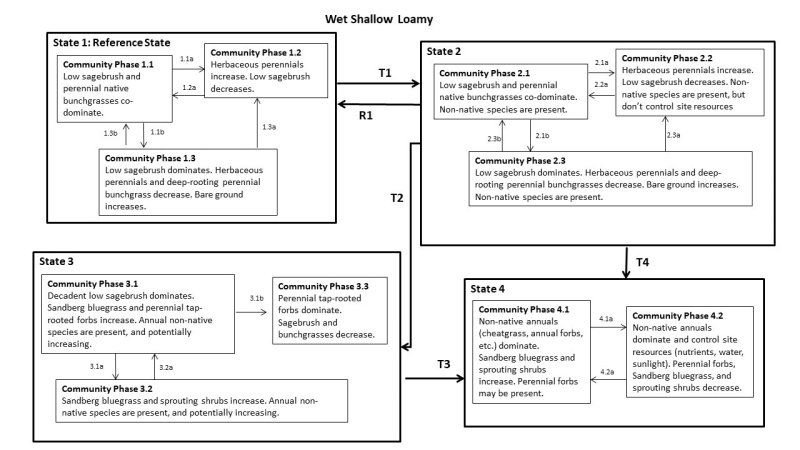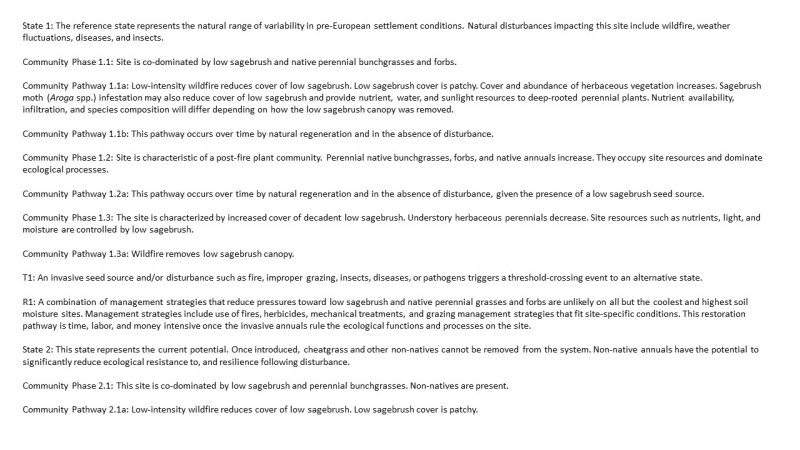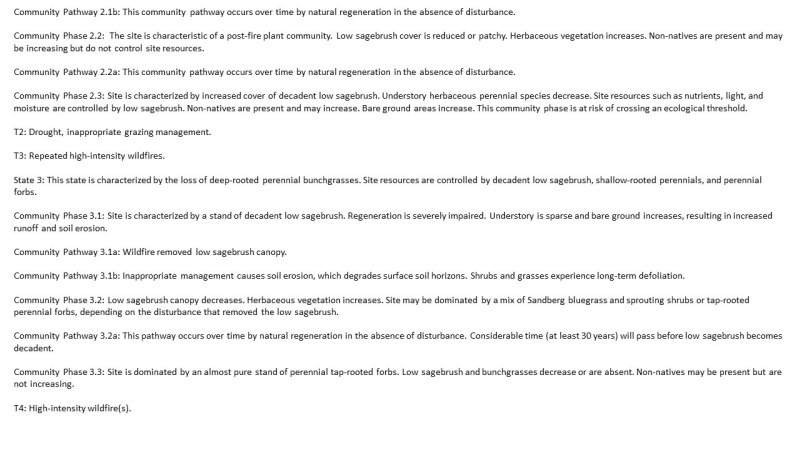Ecological site group R021XG912CA
Wet Shallow Loamy
Last updated: 08/26/2024
Accessed: 12/21/2025
Ecological site group description
Key Characteristics
- Upland sites
- > 30" ppt
- < 20" depth
Provisional. A provisional ecological site description has undergone quality control and quality assurance review. It contains a working state and transition model and enough information to identify the ecological site.
Physiography
This ESG is typically on mountains with 2 to 30 percent slopes. Elevations typically are 5,600 to 8,300 feet (1,700 to 2,500 meters).
Climate
The average annual precipitation in this MLRA is typically 9 to 25 inches (241 to 635 millimeters). It is highest, up to 57 inches (1,450 millimeters), in small areas at high elevations on the western and southwestern edges of this MLRA. Other high precipitation zones are in the scattered mountain ranges throughout the rest of this area. Most of the rainfall occurs as low- or moderate-intensity Pacific frontal storms during the winter. At the higher elevations, rain generally turns to snow. Snow may fall at the lower elevations in winter but does not last. Summers are dry. The average annual temperature is 37 to 53 degrees F (3 to 12 degrees C). The frost-free period is 70 to 185 days and averages 130 days.
This ESG is found primarily in an area of MLRA 21 that receives 30 to 50 inches (760 to 1,270 millimeters) of mean annual precipitation, most of which comes as snow. The mean annual temperature is 38 to 44 degrees F (3 to 12 degrees C), and the frost-free period is only 30 to 60 days.
Soil features
The dominant soils for this ESG are very shallow to shallow, well drained, and formed in volcanic ash and colluvium over residuum derived from andesite, tuff-breccia, or glassy tuff.
Representative soils include the Fingerridge and Skidbrackle series, both of which are ashy-skeletal, glassy, frigid Lithic Argixerolls.
Vegetation dynamics
This habitat is generally dominanted by broad-leaved, evergreen shrubs ranging in height from about 4 to 19 inches (0.1 to 0.5 meters). Average shrub cover is typically 15 percent, but sometimes crowns touch. There may be deciduous shrubs and small trees sparsely scattered within this type. Grasses and forbs are typically sparse, providing 5 to 15 percent ground cover.
Low sagebrush often grows in association with yellow rabbitbrush, antelope bitterbrush, or big sagebrush. Western juniper may be sparsely scattered in stands dominated by low sagebrush, and Utah juniper and singleleaf pinyon are sometimes scattered in stands dominated by black sagebrush. Common grass species include Sandberg bluegrass, bluebunch wheatgrass, bottlebrush squirreltail, Thurber's needlegrass, and Idaho fescue. A rich variety of forbs is usually present. The abundance and distribution of associated plants are highly influenced by soils and precipitation.
This type commonly forms ecotones with the Sagebrush, Pinyon-Juniper, and Juniper habitats in northeastern California. Indeed, it may be difficult to determine the correct classification of some sites. "On the Modoc Plateau, Artemisia arbuscula communities are common as openings within the coniferous forest". They may thus be found adjacent to Mixed Conifer, Jeffrey Pine, or Ponderosa Pine forests. Climatic changes result in periodic shifting of these ecotones, a relationship that is further complicated by invasion of coniferous woodlands into sagebrush habitats in response to fire suppression and grazing by domestic livestock.
Low sagebrush occurs in areas with cold, harsh winters and hot, dry summers. Precipitation generally ranges from 20 to 46 centimeters (8 to 18 inches), falling mostly as snow from December through March. Mean summer maximum temperatures range from 28 to 35 degrees C (83 to 95 degrees F); mean winter minimum range from -13 to -3 degrees C (8 to 27 degrees F). Stands of low sagebrush are "usually found on shallow soils with impaired drainage in the transition zone between the wetter bottom and open timber on the mountainsides." The type also occurs on terraces with hardpan or heavy clay soils. In mosaics formed with bitterbrush, low sagebrush occurs on harsher sites with shallow, well-drained soils, and bitterbrush occupies areas with deeper soils. The clay-rich soils yield much of their snowmelt as runoff, making them very important watershed areas. Perched water tables in spring, which result in poor aeration in the rooting zone of low sagebrush, may be significant in the ecology of the LSG habitat.
Information directly copied from:
California Wildlife Habitat Relationships System
California Department of Fish and Game
California Interagency Wildlife Task Group
By Jared Verner
Major Land Resource Area
MLRA 021X
Klamath and Shasta Valleys and Basins
Stage
Provisional
Click on box and path labels to scroll to the respective text.



